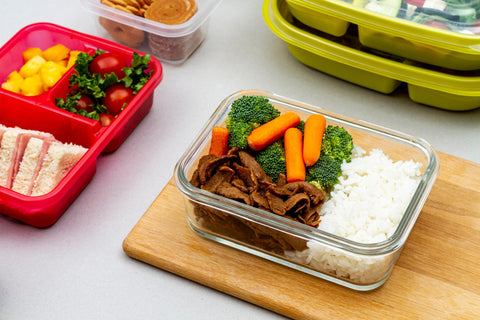
Food storage containers are indispensable in every Indian household, facilitating the preservation of leftovers, meal prepping, and organizing pantry staples. With the abundance of culinary diversity and family traditions in Indian cuisine, choosing the right containers becomes essential for maintaining the freshness and flavours of various dishes. Let's explore the relevance of plastic and glass containers in the context of our households before delving into their specific uses and benefits.
The Importance of Plastic and Glass Containers at Home
In most Indian homes, food holds immense cultural significance, with meals often prepared with love and care, and leftovers cherished for future consumption. Plastic and glass containers play crucial roles in preserving the rich flavours and aromas of Indian dishes while accommodating the diverse needs of busy households and traditional cooking practices.
For Taking Lunch to Office: Plastic
Plastic containers are a staple in households for packing homemade lunches to the office or workplace. Their lightweight and portable nature make them convenient for busy professionals juggling work and family responsibilities.
Here’s why:
Plastic containers are ideal for office-goers, as they are easy to pack and transport without adding extra weight to bags or lunchboxes. Their durability and leak-proof features ensure that traditional Indian meals, such as roti-sabzi or rice-dal, stay fresh and flavourful until lunchtime.
For Packing Lunch for Kids: Plastic
Plastic containers are favoured by parents for packing nutritious and delicious lunches for their children, whether for school or extracurricular activities. Their kid-friendly designs and ease of use make them popular choices for busy mornings.
Here’s why:
Plastic containers are practical solutions for parents, as they are lightweight, durable, and come in vibrant colors and fun shapes that appeal to children. From homemade parathas to fruit salads, plastic containers keep kids satisfied and energized throughout the day.
For Outdoor Camping & Outing: Plastic & Glass
Families going on outdoor adventures or picnics rely on a combination of plastic and glass containers to store and transport a variety of foods, snacks, and beverages. Their versatility and convenience cater to the diverse needs of outdoor enthusiasts.
Here’s why:
Plastic containers are essential for camping trips, as they are lightweight, shatterproof, and easy to clean, making them suitable for storing essentials like spices, condiments, and snacks. Glass containers, meanwhile, are preferred for storing homemade pickles, chutneys, and curries, adding a touch of homemade goodness to outdoor meals.
For Long Journeys: Glass & Plastic
Travelers embarking on long journeys by train, bus, or car rely on a combination of glass and plastic containers to pack homemade snacks, meals, and refreshments. Their durability and versatility ensure that travellers are well-prepared for their culinary adventures on the road.
Here’s why:
Glass containers are ideal for travellers seeking to preserve the freshness and flavour of homemade delicacies like puris, theplas, and dry snacks during long journeys. Plastic containers, on the other hand, are practical solutions for storing liquids, gravies, and chutneys without the risk of leaks or spills.
For Environment: Glass
People are increasingly prioritizing eco-friendly alternatives to reduce plastic waste and minimize their environmental footprint. Glass containers emerge as sustainable options for storing and preserving Indian spices, pulses, and grains while promoting eco-conscious living.
Here’s why:
Glass containers align with the values of Indian households committed to sustainability and environmental conservation. They are reusable, recyclable, and do not release harmful chemicals into the environment, making them ideal choices for storing and organizing pantry essentials for generations to come.
For Health: Glass
Families prioritize health and well-being, especially when it comes to food safety and nutrition. Glass containers offer a safe and hygienic solution for storing homemade curries, dals, and pickles without the risk of chemical leaching or contamination.
Here’s why:
Glass containers are inert and non-porous, ensuring that stored foods retain their freshness, flavours, and nutritional value without absorbing odours or flavours. Unlike plastic containers, which may contain harmful chemicals like BPA, glass containers provide peace of mind to families concerned about food safety and health.
For Storing Food in the Fridge: Glass & Plastic
Households rely on both glass and plastic containers for organizing and storing a wide range of foods and leftovers in the refrigerator. Their versatility and compatibility cater to the diverse culinary needs and preferences of Indian families.
Here’s why:
Glass containers are preferred for storing acidic or oily Indian dishes like curries, gravies, and pickles, as they do not react with ingredients or impart unwanted flavours. Plastic containers, meanwhile, are practical solutions for storing dry snacks, chopped vegetables, and leftover rotis or rice, maximizing fridge space and minimizing food waste.
Conclusion
In most kitchens, the choice between plastic and glass containers hinges on practicality, tradition, and personal preferences. Plastic containers offer convenience and portability for on-the-go meals, while glass containers ensure food safety, freshness, and eco-conscious living. By understanding the unique uses and benefits of each material, households can make informed decisions to enhance their culinary experiences and preserve the rich flavours and aromas of homemade meals. Cheers to a well-stocked kitchen and memorable dining moments in every home!

